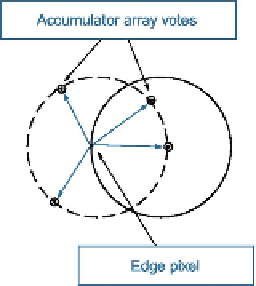Image Processing Reference
In-Depth Information
FIGURE 2
Voting in classic circular Hough transforms.
On the other hand, data mining techniques have gained popularity as illustrative and pre-
dictive applications of image analysis, and researchers have used the two techniques on blood
cell detection data. The neural network (NN) is one of these techniques, and it has been suc-
cessfully applied in the identification and control of dynamic systems. In 1986, David Rumel-
hart introduced concepts related to the NN when he presented a back-propagation process,
which used many layers throughout the network.
Another technique of data mining is the classification and regression tree (C&R), which is
the most common and powerful technique for classifying data and predicting outcomes in the
decision tree (DT). It can generate understandable rules and handle both continuous and cat-
to two features: (1) the procedures are relatively straightforward to understand and explain,
and (2) the procedures address a number of data complexities, such as nonlinearly and inter-
actions, that commonly occur in real data [
4
].
This chapter is divided into two parts. In the first part, I apply a proposed algorithm to de-
tect benign and distorted blood cells (sickle-cell anemia) and to count them depending on the
segmentation of their shapes using CHT, watershed, and morphological tools. In the second
part, I introduce an algorithm for checking and analyzing the resulting cell data variables (e.g.,
area, convex area, perimeter, and eccentricity) by applying the most important techniques in
To this end, the chapter is organized as follows:
Section 2
focuses on the related work which
is presenting a literature review on the work in this chapter, and
Section 3
presents the dein-
2 Related work
In recent years, research on the blood cells' detection and diagnosis of diseases using image
processing has grown rapidly. In 2010, Y M Hirimutugoda and Gamini Wijayarathna presen-
ted a method to detect thalassaemia and malarial parasites in blood sample images acquired
from light microscopes and investigated the possibility of rapid and accurate automated dia-
gnosis of red blood cell disorders. To evaluate the accuracy of the classification in the recogni-

Search WWH ::

Custom Search